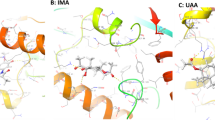Abstract
The bisquinoline drug dequalinium (DQ) has demonstrated remarkable activity against some infection diseases, including malaria. Oxidative stress represents a biochemical target for potential antimalarials. In this work, we have tested the ability of this compound to modify the oxidative status in Plasmodium berghei-infected erythrocytes. After hemolysis, activities of superoxide dismutase (SOD), catalase (CAT), glutathione cycle, and dehydrogenase enzymes were investigated. The activity of glucose-6-phosphate dehydrogenase (G6PD) and 6-phosphogluconate dehydrogenase (6PGLD) in infected cells were diminished by this drug compared to controls (300% and 80% approximately, respectively), while glutathione peroxidase (GPx), glutathione transferase (GST), and glutathione levels were also lowered. As a compensatory response, we could appreciate an increase of SOD activity (20% approximately) in infected cells treated with DQ; however, catalase was not affected by the compound. Lipid peroxidation was also decreased by this drug, protecting the cells from the hemolysis caused by the infection. In conclusion, oxidative stress represents a biochemical event which is modulated by DQ, interfering with the antioxidant regular activities in P. berghei infection.



Similar content being viewed by others
References
Aebi H (1984) Catalase in vitro. Methods Enzymol 103:121–126
Areekul S, Boonme Y (1986) Catalase activity in red cell and liver of mice infected with Plasmodium berghei. Southeast Asian J Trop Med Public Health 17:48–52
Atamna H, Ginsburg H (2005) Heme degradation in the presence of glutathione. J Biol Chem 27:24876–24883
Becker K, Tilley L, Vennerstrom DR, Rogerson S, Ginsburg H (2004) Oxidative stress in malaria parasite-infected erythrocytes: host-parasite interactions. Int J Parasitol 34:163–189
Bendrat K, Berger BJ, Cerami A (1995) Haem polymerization in malaria. Nature 378:138
Bergmeyer HU, Gawehn K, Grassl M (1974) Glucose-6-phosphate dehydrogenase. In: Bergmeyer HU (ed) Methods of enzymatic Analysis vol. 2. Academic, New York, pp 458–459
Bernt E, Bergmeyer HU (1974) Isocitrate dehydrogenase. In: Bergmeyer HU (ed) Methods of enzymatic analysis vol. 2. Academic, New York, pp 624–631
Buege JA, Aust SD (1978) Microsomal lipid peroxidation. Methods Enzymol 52C:302–310
Das BS, Nanda NK (1999) Evidence for erythrocyte lipid peroxidation in acute falciparum malaria. Trans R Soc Trop Med Hyg 93:58–62
Della Casa V, Noll H, Gonser S, Grob P, Graf F, Pohlig G (2002) Antimicrobial activity of dequalinium chloride against leading germs of vaginal infections. Arzneimittelforschung 52:699–705
Farombi EO, Shyntum YY, Emerole GO (2003) Influence of chloroquine treatment and Plasmodium falciparum malaria infection on some enzymatic and non-enzymatic antioxidant defense indices in humans. Drug Chem Toxicol 26:59–71
Flohé L, Günzler WA (1984) Assays of glutathione peroxidase. Methods Enzymol 77:398–404
Francis SE, Sullivan DJ Jr, Goldberg DE (1997) Hemoglobin metabolism in the malaria parasite Plasmodium falciparum. Annu Rev Microbiol 51:97–123
Ginsburg H, Atamna H (1994) The redox status of malaria-infected erythrocytes: an overview with an emphasis on unresolved problems. Parasite 1:5–13
Goldberg DE, Slater AF, Cerami A, Henderson GB (1990) Hemoglobin degradation in the malaria parasite Plasmodium falciparum: an ordered process in a unique organelle. Proc Natl Acad Sci U S A. 87:2931–2935
Greenwod B, Mutabingwa T (2002) Malaria in 2002. Nature 415:670–678
Griffiths MJ, Ndungu F, Baird KL, Muller DPR, Marsh K (2001) Oxidative stress and erythrocyte damage in Kenya children with severe Plasmodium falciparum malaria. Br J Haematol 113:486–491
Harwaldt P, Rahlfs S, Becker K (2002) Glutathione-S-transferase of the malarial parasite Plasmodium falciparum: characterization of a potential drug target. Biol Chem 383:821–830
Hbig WH, Pabst MJ, Jakoby WB (1974) Glutathione-S-transferases. The first enzymatic step in mercapturic acid formation. J Biol Chem 249:7130–7139
Kaufman AY (1981) The use of dequalinium acetate as a disinfectant and chemotherapeutic agent in endodontics. Oral Surg Oral Med Oral Pathol 51:434–441
King J (1974) 6-Phosphogluconate dehydrogenase. In: Bergmeyer HU (ed) Methods of enzymatic analysis vol. 2. Academic, New York, pp 632–635
Loria P, Miller S, Folley M, Tilley L (1999) Inhibition of the peroxidative degradation of haem as the basis of action of chloroquine and other quinoline antimalarials. Biochem J 339:363–370
Lowry OH, Rosebrough NJ, Farr AL, Randall R (1951) Protein measurement with the Folin phenol reagent. J Biol Chem 193:265–275
Lüersen K, Walter RD, Müller S (2000) Plasmodium falciparum-infected red blood cells depend on a functional glutathione de novo synthesis attributable to an enhanced loss of glutathione. Biochem J 346:545–552
Makler MT (1990) Dequalinum salts for the treatment of malaria. (Flow, Inc., USA). U.S. Patent 4.946.849
McCord JM, Fridovich I (1969) Superoxide dismutase. An enzymic function for erythrocuprein (hemocuprein). J Biol Chem 244:6049–6053
Omodeo-Salé F, Motti A, Basilico N, Parapini S, Olliaro P, Taramelli D (2003) Accelerated senescence of human erythrocytes cultured with Plasmodium falciparum. Blood 102:705–711
Rodrigues J, Gamboa N (2007) Plasmodium berghei: in vitro and in vivo activity of Dequalinium. Exp Parasitol 115:19–24
Sancho P, Galeano E, Nieto E, Delgado MD, García-Pérez AL (2007) Dequalinium induces cell death in human leukemia cells by early mitochondrial alterations which enhance ROS production. Leuk Res 31:969–978
Shakespare PG, Trigg PI, Kyd SI, Tappenden L (1979) Glucose metabolism in the simian malaria parasite Plasmodium knowlesi: activities of the glycolytic and pentose phosphate pathways during the intraerythrocytic cycle. Ann Trop Med Parasitol 73:407–415
Srivastava P, Puri SK, Dutta GP, Pandey VC (1992) Status of oxidative stress and antioxidant defences during Plasmodium knowlesi infection and chloroquine treatment in Macaca mulatta. Int J Parasitol 22:243–245
Tietze F (1969) Enzymatic method for quantitative determination of nanogram amounts of total and oxidized glutathione. Anal Biochem 27:502–522
Acknowledgements
We thank Neuropeptide Laboratory, School of Pharmacy, Central University of Venezuela, for the disposition of the microplate spectrophotometer. This work was supported by Consejo de Desarrollo Científico y Humanístico (CDCH), Universidad Central de Venezuela (Grants PG-CDCH-06.30.5125-2003). The experiments complied with the current laws in Venezuela.
Author information
Authors and Affiliations
Corresponding authors
Rights and permissions
About this article
Cite this article
Rodrigues, J.R., Gamboa, N.D. Effect of dequalinium on the oxidative stress in Plasmodium berghei-infected erythrocytes. Parasitol Res 104, 1491–1496 (2009). https://doi.org/10.1007/s00436-009-1355-7
Received:
Accepted:
Published:
Issue Date:
DOI: https://doi.org/10.1007/s00436-009-1355-7




